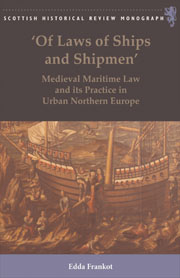Book contents
- Frontmatter
- Contents
- Tables and Maps
- Abbreviations
- Acknowledgements
- Preface
- Introduction
- 1 A History of Maritime Law in Northern Europe
- 2 Shipwreck, Jettison and Ship Collision in Maritime Law
- 3 The Five Towns Introduced
- 4 Written Law: Urban Collections of Sea Law
- 5 Written Law: Local Developments in Lawmaking
- 6 Legal Practice: the Administration of Maritime Justice
- 7 Legal Practice: Maritime Proceedings at the Urban Courts
- Final Conclusions
- Bibliography
- Index
1 - A History of Maritime Law in Northern Europe
Published online by Cambridge University Press: 05 August 2013
- Frontmatter
- Contents
- Tables and Maps
- Abbreviations
- Acknowledgements
- Preface
- Introduction
- 1 A History of Maritime Law in Northern Europe
- 2 Shipwreck, Jettison and Ship Collision in Maritime Law
- 3 The Five Towns Introduced
- 4 Written Law: Urban Collections of Sea Law
- 5 Written Law: Local Developments in Lawmaking
- 6 Legal Practice: the Administration of Maritime Justice
- 7 Legal Practice: Maritime Proceedings at the Urban Courts
- Final Conclusions
- Bibliography
- Index
Summary
In early sea shipping the roles of skippers, shipowners and merchants usually overlapped. As a consequence, maritime law was simple, required only to regulate situations in which two ships collided. Gradually, however, more and more people became involved in the freighting of a single ship, and a differentiation eventually emerged between the roles of skippers, merchants, shipowners and crew members. Maritime law became correspondingly more complicated since remedies were required to reconcile points of conflict between the expanding cast of maritime society. Following regional developments in shipping technology, these regulations evolved differently in the various regions of Europe and, more particularly for the present purpose, of northern Europe. The oldest surviving regulations in northern Europe are from Scandinavia and date to the late twelfth century.
Ships that were built specifically for the transportation of bulk cargo probably first appeared in the tenth century. Before that time, the early Viking Age ships were built to carry both warriors and small amounts of cargo. These ships were ideal for raiding the coastal areas of northern Europe, but when the Vikings consolidated their political position in the area and shifted their emphasis to trading instead of raiding, changes occurred in Scandinavian shipbuilding. On the one hand, longships were built to carry personnel swiftly across the waters for military and defensive purposes. On the other hand, broad ships appeared which were specialised in carrying cargo.
- Type
- Chapter
- Information
- Of Laws of Ships and ShipmenMedieval Maritime Law and its Practice in Urban Northern Europe, pp. 6 - 26Publisher: Edinburgh University PressPrint publication year: 2012



